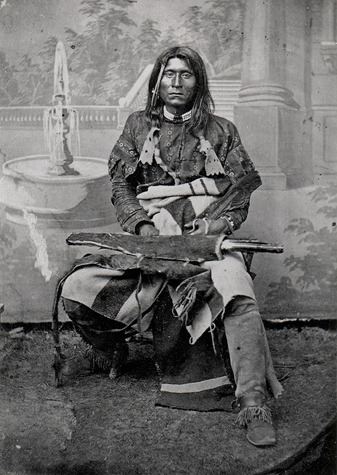<Back to Index>
- Chief of the Modoc Kintpuash (Captain Jack), 1837
PAGE SPONSOR

Kintpuash (Strikes the water brashly), better known as Captain Jack (circa 1837 - October 3, 1873), was a chief of the Native American Modoc tribe of California and Oregon, and was their leader during the Modoc War.
In 1864, the Modoc lived with each other in their ancestral home near Tule Lake, on the California - Oregon border. However, due to the desire of white settlers to farm the fertile land, they were moved to the Klamath Reservation in southwestern Oregon, home of their traditional rivals, the Klamath tribe. As the Klamath outnumbered their newcomers, and the reservation was on traditional Klamath land, the Modoc were poorly treated.
In 1865, Kintpuash, a Modoc leader better known as Captain Jack, led the Modoc people from the reservation back to their home. In 1869, the Modoc were rounded up by the United States Army and returned to the Klamath Reservation, but conditions had not improved, and Captain Jack led a band of about 180 Modoc to the Tule Lake area in April, 1870.
In 1872 the Army was sent to capture Captain Jack's band and return them to the reservation. On November 29, while negotiating their surrender at the Lost River in Oregon, fighting broke out between a soldier and one of the Modoc warriors. The brief Battle of Lost River ensued, and Jack took the opportunity to lead his band into the wastelands of what is now Lava Beds National Monument. The band settled in a natural fortress, now known as Captain Jack's Stronghold, consisting of many caves and trenches in the lava beds. When they were finally located, the Army quickly launched an attack on January 17, 1873; the Army was left with 35 dead and many wounded, while the Modoc suffered no casualties.
Captain Jack's advisers, apparently not attuned to relevant differences between Modoc and Euro - American culture, suggested that the Army would leave in response to killing their leader, General Edward Canby. Jack hoped, to the contrary, for a peaceful solution to the conflict, and entered into negotiations with a Federal peace commission. During the months long negotiations, the Modoc hawks gained in influence. Jack was shamed, his opponents throwing the hat of a Modoc woman at him to symbolically strip him of his manhood. To bolster his influence, Jack agreed to their plan: he called for a meeting with the commission (of which Canby was by then the chair) with the intention of killing them all. During a conference on April 11, Captain Jack and several other Modocs drew pistols upon a prearranged signal, and killed two leading members of the commission; Captain Jack fatally shot Canby and Boston Charley dispatched Californian clergyman Reverend Eleazar Thomas. Canby was the only general killed during the Indian Wars (Custer's permanent rank was lieutenant colonel). The murder had far from the desired effect, and Canby's successor, General Jefferson C. Davis, brought in over 1000 soldiers as reinforcements. On April 14, the Army again attacked the stronghold, this time forcing the Modoc to flee.
Over the next several months, various groups of Modoc continued to fight the army, while others began to surrender. Captain Jack successfully avoided the Army until a number of Modoc agreed to hunt him down and turn him in; these men included Hooker Jim, Bogus Charley, Shacknasty Jim and Steamboat Frank. On June 1, Captain Jack surrendered, ceremonially laying down his rifle. He was taken to Fort Klamath, and on October 3, 1873 he was hanged for the murder of General Canby and Reverend Thomas. Black Jim, John Schonchin and Boston Charley were hanged with him.
After the execution, Captain Jack's body was transported by freight train to Yreka, with reports that the body was embalmed to be used as a carnival attraction in the Eastern states. This was unproven and attributed to the army's attempt at secrecy; in reality all the hanged men's heads were severed from their bodies at Fort Klamath, and sent on October 25 by train to the collections of the Army Medical Museum in Washington, D.C. In 1898, the skulls were transferred to the Smithsonian Institution. In the 1970s, descendants of Captain Jack learned that the skull was at the Smithsonian. In 1984, the Smithsonian returned the remains to Kintpuash's relatives, along with the skulls of Boston Charley, Black Jim and John Schonchin and an unknown woman from the Lava Beds.
The "Captain Jack Substation", a Western Area Power Administration (WAPA) electrical substation named in Kintpuash's honor, is located near Captain Jack's Stronghold. It forms the northern end of Path 66, a high power electric transmission line.
Charles Bronson plays Captain Jack in the 1954 western Drum Beat.
Captain Jack was a central character in Terry Johnston's historical novel Devil's Backbone: The Modoc War, 1872-3 (1991).